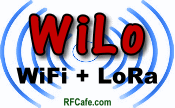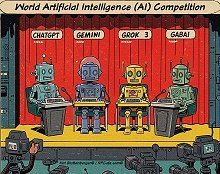Electronics & Technology
- See Full List of AI Topics -

As of this writing, there is no official logo for the WiLo
wireless standard. I (Kirt Blattenberger) created this logo as a place holder.
The WiLo committee is welcome to use it at no cost, so long as credit it given.
WiLo, a
hybrid wireless communications protocol combining Wi-Fi and Long Range (LoRa)
technology, is designed to leverage the strengths of both systems to provide
versatile and energy-efficient connectivity. WiLo emerged to address the growing
demand for a communications standard that could handle both short-range,
high-bandwidth tasks as well as long-range, low-power requirements - ideal for
IoT (Internet of Things) applications. It integrates the high-speed data
transmission capabilities of Wi-Fi with the long-range, low-power benefits of
LoRa, creating a flexible protocol capable of adapting to a wide range of
environments and use cases.
The development of WiLo was a collaborative effort involving multiple
organizations, including key companies such as Cisco, Semtech (the developer of
LoRa technology), and Qualcomm, as well as academic institutions and research
bodies. One of the significant contributors to the WiLo protocol's advancement
has been the Institute of Electrical and Electronics Engineers (IEEE), which has
played a vital role in the standardization process. The IEEE, as the world's
largest technical professional organization focused on advancing technology,
provided critical guidance in establishing the technical framework for WiLo. The
organization's work in creating standardized protocols for wireless
communication, particularly through the IEEE 802 standards that govern Wi-Fi and
other wireless technologies, laid the groundwork for WiLo's development. WiLo's
architecture was influenced by existing IEEE standards such as 802.11 (Wi-Fi)
and 802.15.4 (used in low-power wireless networks like Zigbee), which helped
define its compatibility and operational efficiency.
The IEEE's involvement in WiLo has gone beyond just technical specifications.
Through its publications, conferences, and collaborative projects, the IEEE has
fostered discussions and research on combining wireless systems like Wi-Fi and
LoRa. Several IEEE working groups and committees, particularly those associated
with the Internet of Things and wireless sensor networks, have explored the
practical applications of WiLo in areas like smart cities, industrial IoT, and
large-scale sensor networks. IEEE-sponsored academic research has also
contributed to the understanding of how Wi-Fi and LoRa can operate in tandem,
focusing on the challenges of interoperability, power efficiency, and spectrum
management. Research institutions such as MIT and Stanford University, many of
whose members are also IEEE fellows, have led studies into optimizing hybrid
wireless networks, which has informed key aspects of WiLo's design.
WiLo's primary features reflect its hybrid nature, with the ability to toggle
between Wi-Fi and LoRa modes depending on the requirements of the application.
It enables high-bandwidth tasks such as video streaming and real-time data
transfer using Wi-Fi while leveraging LoRa's long-range, low-power capabilities
for energy-efficient communication across vast distances. WiLo operates in both
2.4 GHz and 5 GHz frequency bands for Wi-Fi and sub-GHz bands for LoRa, ensuring
broad compatibility and efficient spectrum use. The IEEE's extensive work on
radio spectrum utilization and interference management has helped address
potential issues with spectrum congestion, ensuring that WiLo operates smoothly
even in dense wireless environments.
WiLo's strengths are evident in its adaptability and ability to support
diverse applications. For IoT deployments, it offers the best of both worlds:
the high-speed data rates of Wi-Fi and the long-range, low-power communication
of LoRa. This makes WiLo ideal for a wide array of environments, from smart
homes and industrial automation to agricultural monitoring and smart cities.
IEEE's contributions, particularly in ensuring the protocol's compliance with
global wireless standards, have been crucial in driving the adoption of WiLo
across different industries. The protocol also benefits from IEEE's focus on
security standards, which has helped WiLo incorporate robust encryption and
secure communication mechanisms to protect data transmission.
However, WiLo does face challenges, some of which stem from the complexity of
integrating two very different communication technologies. The need to manage
seamless transitions between Wi-Fi and LoRa modes introduces significant
technical challenges, particularly in ensuring consistent performance across
different environments. Additionally, while Wi-Fi offers high-speed
communication, its range is limited compared to LoRa, which sacrifices data
throughput for extended coverage. The IEEE's ongoing efforts in improving
multi-protocol networks have been critical in addressing these issues,
particularly through its research into adaptive communication systems that
dynamically adjust based on network conditions.
WiLo's deployment plans have already begun to take shape, with early-stage
trials in IoT ecosystems and smart city applications. Several pilot programs
have been initiated, particularly in Europe and the U.S., where WiLo is being
tested for applications like environmental monitoring, energy management, and
public safety. Agricultural deployments, where long-range communication is
needed to connect sensors spread over large farms, are another key area where
WiLo is expected to make a substantial impact. The IEEE has been instrumental in
supporting these deployments, working with industry partners to develop use
cases and frameworks for large-scale WiLo implementation. Through its various
conferences and workshops, such as those organized by the IEEE Internet of
Things Community, the organization has promoted knowledge sharing and best
practices, facilitating the integration of WiLo into existing IoT
infrastructures.
WiLo's development timeline began in the mid-2010s, as the limitations of
individual wireless technologies became more apparent in the context of
large-scale IoT networks. By 2017, experimental versions of WiLo were
introduced, and by 2019, the technical specifications were finalized through a
collaborative process involving industry, academia, and IEEE standards bodies.
Companies like Semtech, Cisco, and Qualcomm were instrumental in driving this
process, alongside contributions from research universities and IEEE-affiliated
researchers. In 2021, the WiLo standard was finalized, and the first commercial
deployments followed shortly after in 2022. Key figures in the WiLo development
include Nicolas Sornin from Semtech, a leading figure in LoRa technology, and
Dr. Sanjay Jha of Qualcomm, who contributed to the integration of Wi-Fi and
LoRa. Academic contributors like Professor Hari Balakrishnan from MIT and
Professor Andrea Goldsmith from Princeton, both IEEE Fellows, also played
pivotal roles in advancing WiLo's capabilities.
The IEEE's influence on WiLo extends beyond technical standards to its
broader support for innovation in wireless technology. The organization has
worked closely with governmental and industry bodies to promote the adoption of
WiLo, ensuring that it meets the needs of both public and private sector users.
Governments in the European Union and the U.S., through programs like Horizon
2020 and the National Science Foundation (NSF), have provided funding for
research and pilot projects that explore WiLo's applications in smart
infrastructure and energy management. The IEEE has also engaged with regulatory
bodies to ensure that WiLo complies with global telecommunications regulations,
further enabling its deployment on a global scale.
In conclusion, WiLo represents a significant step forward in wireless
communication, combining the high-speed capabilities of Wi-Fi with the
long-range, low-power benefits of LoRa. The IEEE has played an essential role in
this development, from standardization and spectrum management to fostering
academic and industry collaboration. As WiLo continues to evolve, its
flexibility and efficiency make it a critical protocol for the future of IoT,
smart cities, and industrial automation. With the ongoing support of IEEE and
its global network of contributors, WiLo is poised for widespread adoption and
continued innovation across numerous sectors.
 This content was generated by primarily
with the assistance of ChatGPT (OpenAI), and/or
Gemini (Google), and/or
Arya (GabAI), and/or Grok
(x.AI), and/or DeepSeek artificial intelligence
(AI) engines. Review was performed to help detect and correct any inaccuracies; however,
you are encouraged to verify the information yourself if it will be used for critical
applications. In all cases, multiple solicitations to the AI engine(s) was(were)
used to assimilate final content. Images and external hyperlinks have also been
added occasionally - especially on extensive treatises. Courts have ruled that AI-generated
content is not subject to copyright restrictions, but since I modify them, everything
here is protected by RF Cafe copyright. Many of the images are likewise generated
and modified. Your use of this data implies an agreement to hold totally harmless
Kirt Blattenberger, RF Cafe, and any and all of its assigns. Thank you. Here is
Gab AI in an iFrame. This content was generated by primarily
with the assistance of ChatGPT (OpenAI), and/or
Gemini (Google), and/or
Arya (GabAI), and/or Grok
(x.AI), and/or DeepSeek artificial intelligence
(AI) engines. Review was performed to help detect and correct any inaccuracies; however,
you are encouraged to verify the information yourself if it will be used for critical
applications. In all cases, multiple solicitations to the AI engine(s) was(were)
used to assimilate final content. Images and external hyperlinks have also been
added occasionally - especially on extensive treatises. Courts have ruled that AI-generated
content is not subject to copyright restrictions, but since I modify them, everything
here is protected by RF Cafe copyright. Many of the images are likewise generated
and modified. Your use of this data implies an agreement to hold totally harmless
Kirt Blattenberger, RF Cafe, and any and all of its assigns. Thank you. Here is
Gab AI in an iFrame.
AI Technical Trustability Update
While working on an update to my
RF Cafe Espresso Engineering Workbook project to add a couple calculators about
FM sidebands (available soon). The good news is that AI provided excellent VBA code
to generate a set of Bessel function
plots. The bad news is when I asked for a
table
showing at which modulation indices sidebands 0 (carrier) through 5 vanish,
none of the agents got it right. Some were really bad. The AI agents typically explain
their reason and method correctly, then go on to produces bad results. Even after
pointing out errors, subsequent results are still wrong. I do a lot of AI work
and see this often, even with subscribing to professional versions. I ultimately
generated the table myself. There is going to be a lot of inaccurate information
out there based on unverified AI queries, so beware.
Electronics & High Tech
Companies | Electronics &
Tech Publications | Electronics &
Tech Pioneers | Electronics &
Tech Principles |
Tech Standards Groups &
Industry Associations | Societal
Influences on Technology
|









